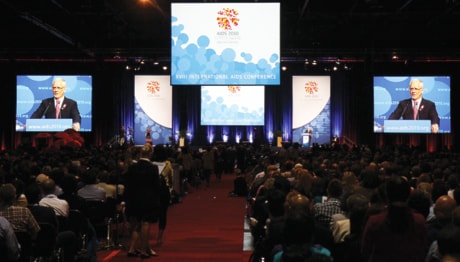The introduction of antiretroviral therapy has not only transformed HIV from a virtual death sentence into a manageable disease, but treatment also appears to slash the number of new infections, Canadian researchers say.
In a study presented Sunday at the International AIDS Conference in Vienna, the Vancouver researchers found that new HIV cases in British Columbia have dropped by more than 50 per cent since 1996, when the drug cocktail known as HAART was launched.
“We found a very strong relation between the number of patients on treatment and the number of new HIV infections diagnosed,” said principal investigator Dr. Julio Montaner, director of the B.C. Centre for Excellence in HIV-AIDS.
“This was a negative correlation, meaning the more people you have on treatment, the less people become infected.”
HAART, or highly active antiretroviral therapy, is a multi-drug treatment that suppresses replication of the AIDS virus in immune cells, thereby reducing the amount of virus in the blood and other bodily fluids — and the chance of transmitting it to another person. HIV is primarily contracted through sex and the sharing of needles by illicit drug users.
Montaner, president of the International AIDS Society, said that for every 100 additional patients started on antiretroviral therapy, the number of new HIV cases fell by three per cent.
“That may sound like a small number, but when you prevent one infection ... you are preventing that infection plus the infection that infection would have generated down the road,” he said from Vienna.
“It represents a return on investment that grows over time. This is like putting money in the bank and letting it grow for years to come.”
To conduct the study, the researchers used 1996-2009 provincial health records to examine how many people were prescribed the drugs and how many new HIV cases were diagnosed during the period. They found the number of patients receiving the therapy overall rose more than five-fold, to 5,413 from 837, while new diagnoses per year fell by 52 per cent to 338 from 702.
The authors, whose work is published online Sunday in The Lancet, say the annual drop in new cases was largely driven by people with a history of IV drug use; new HIV diagnoses were almost halved among that group, many of whom live in Vancouver’s Downtown Eastside.
Montaner said testing showed that average viral load — the measure of HIV in an infected person’s blood — among people in that community also went down as the use of HAART was ramped up over time.
He said the research team looked to see whether other factors, such as more intensive AIDS-prevention education, harm-reduction strategies or safer sexual behaviour, might have contributed to the decline in cases. But that doesn’t seem to be the case.
“We looked at rates of hepatitis C, syphilis, chlamydia, gonorrhea — the typical markers of blood-borne or sexually transmitted infections — and what we have found is that during the period in question, the trend for all of these diseases in British Columbia was either flat or actually rising.”
Montaner said research by the B.C. centre has helped the UN shape its new $26-billion-per-year Treatment 2.0 initiative, which calls for 15 million people worldwide to receive antiretroviral drugs — triple the number currently getting the treatment.
Michel Sidibe, executive director of UNAIDS, said antiretroviral therapy is a smart health investment because it cuts rates of HIV, TB as well as maternal and child deaths.
“The most recent evidence presented by the B.C. Centre for Excellence in HIV-AIDS and other leading research organizations supports these facts and tells us that we need to introduce treatment earlier,” Sidibe said in a statement. “Treatment not only saves lives, it can be one of the most compelling prevention tools we have.”
In a Lancet commentary accompanying the study, infectious disease specialists doctors Franco Maggiolo and Sebastiano Leone of Bergamo, Italy, say antiretroviral therapy might be effective within populations elsewhere, but should also be used with programs aimed at reducing the risk of transmission.
“While waiting for an effective vaccine, experiences such as those reported ... should be strongly considered by clinicians, national and international agencies, policy makers, and all parties involved in the development of treatment guidelines,” they write, “because the population-based dimension of HAART might play an important part in the future control of the HIV epidemic.”
More than 33 million people worldwide are infected with HIV. Each day, at least 7,400 people become infected with the virus and nearly 5,500 die from complications of AIDS.
Montaner said at the Gleneagles, Scotland, summit in 2005, the Group of Eight made a commitment to provide worldwide universal access to HIV treatment by the end of 2010, but so far only about 40 per cent coverage has been achieved.
Canada had an opportunity at the recent G8 meeting in Huntsville, Ont., to reassert that commitment, but the federal government instead focused on maternal and child health, leaving AIDS “very low on the agenda” considered by world leaders, he said.
While welcoming the pledge to improve the health of mothers and children, Montaner said he and other HIV researchers and patient advocates wanted to see a renewed commitment to universal access to treatment for people with HIV.
Her said one-third of women of reproductive age in southern Africa are infected with HIV, and research has shown that antiretrovirals dramatically cut the rate of transmission of the virus to babies.
“So you’re deluding yourself if you pretend that you’re going to have a maternal health program that doesn’t first address the problem of HIV.”
